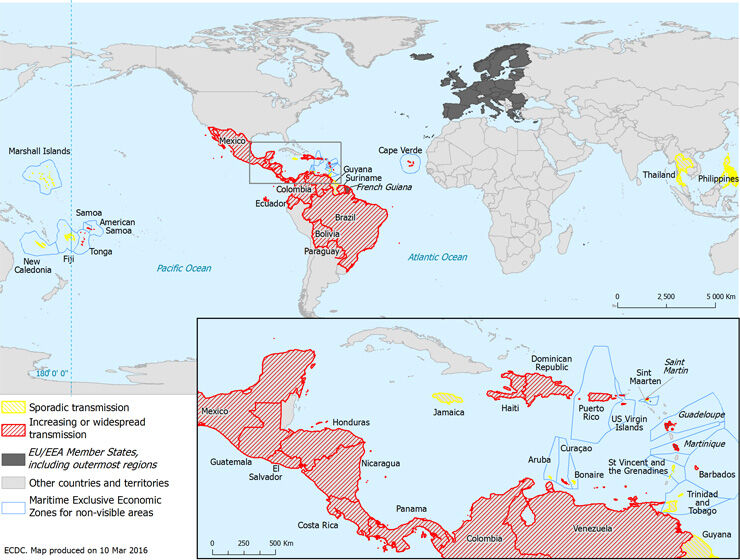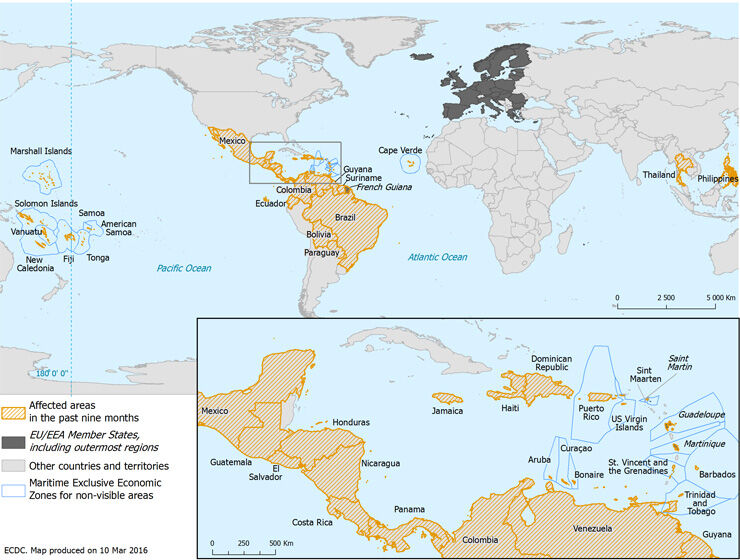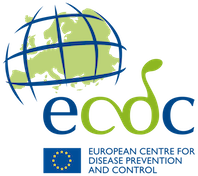Epidemiological update: Outbreaks of Zika virus and complications potentially linked to the Zika virus infection, 9 March 2016
Since last week, the Philippines and Fiji confirmed the first autochthonous cases of Zika virus transmission in 2016.
New developments since the last epidemiological update published on 3 March 2016
On 8 March, WHO published a statement following the second meeting of the IHR 2005 Emergency Committee on Zika virus and observed increase in neurological disorders and neonatal malformations. The Director-General declared the continuation of the Public Health Emergency of International Concern (PHEIC) and issued temporary recommendations including advice to pregnant women to postpone travel to Zika affected areas.
Lao People’s Democratic Republic: According to media quoting the Ministry of Health and Institut Pasteur du Laos, Zika virus has been identified in blood samples from 19 residents of Vientiane who were infected between 2012 and 2015.
United States: On 9 March, the Florida Department of Health reported the first case of sexual transmission of Zika virus in Florida.
Publications
On 4 March, the New England Journal of Medicine published a preliminary report on Zika virus infection in pregnant women in Rio de Janeiro. Fetal ultrasonography was performed in 42 Zika virus positive-women (58%) and in 16 Zika virus-negative women. Fetal abnormalities were detected in 12 of the 42 Zika-positive women (29%) and in none of the Zika virus-negative women.
A Morbidity and Mortality Report (MMWR) published by the US CDC provides temporal and geospatial evidence linking febrile rash illness consistent with Zika virus disease during the first trimester of pregnancy with the increased birth prevalence of microcephaly in Brazil 2015.
Detailed epidemiological situation
As of 10 March 2016, autochthonous cases of Zika virus infection have been reported from 40 countries and territories worldwide in the past two months (see Table 1 and Figure 1). Forty-two countries and territories have reported autochthonous cases of Zika virus infection in the past nine months (see Table 1 and Figure 2).
Several countries in the Americas, Caribbean and the Pacific continue to report an increase in autochthonous cases of Zika virus infection.
Table 1. Countries and territories with reported confirmed autochthonous cases of Zika virus infection in the past two months, as of 10 March 2016
Country and territories |
Affected in the past 2 months |
Affected in the past 9 months |
|---|---|---|
American Samoa |
Increasing or widespread transmission |
Yes |
Aruba |
Sporadic transmission |
Yes |
Barbados |
Increasing or widespread transmission |
Yes |
Bolivia |
Increasing or widespread transmission |
Yes |
Brazil |
Increasing or widespread transmission |
Yes |
Bonaire |
Sporadic transmission |
Yes |
Cape Verde |
Increasing or widespread transmission |
Yes |
Colombia |
Increasing or widespread transmission |
Yes |
Costa Rica |
Increasing or widespread transmission |
Yes |
Curaçao |
Increasing or widespread transmission |
Yes |
Dominican Republic |
Increasing or widespread transmission |
Yes |
Ecuador |
Increasing or widespread transmission |
Yes |
El Salvador |
Increasing or widespread transmission |
Yes |
Fiji |
Sporadic transmission | Yes |
French Guiana |
Increasing or widespread transmission |
Yes |
Guadeloupe |
Increasing or widespread transmission |
Yes |
Guatemala |
Increasing or widespread transmission |
Yes |
Guyana |
Sporadic transmission | Yes |
Haiti |
Increasing or widespread transmission |
Yes |
Honduras |
Increasing or widespread transmission |
Yes |
Jamaica |
Sporadic transmission |
Yes |
Marshall Islands |
Sporadic transmission |
Yes |
Martinique |
Increasing or widespread transmission |
Yes |
Mexico |
Increasing or widespread transmission |
Yes |
New Caledonia |
Sporadic transmission |
Yes |
Nicaragua |
Increasing or widespread transmission |
Yes |
Panama |
Increasing or widespread transmission |
Yes |
Paraguay |
Increasing or widespread transmission |
Yes |
| Philippines | Sporadic transmission | Yes |
Puerto Rico |
Increasing or widespread transmission |
Yes |
Saint Martin |
Increasing or widespread transmission | Yes |
Saint Vincent and the Grenadines |
Sporadic transmission |
Yes |
Samoa |
Increasing or widespread transmission |
Yes |
Sint Maarten |
Sporadic transmission |
Yes |
Solomon Islands |
No |
Yes |
Suriname |
Increasing or widespread transmission |
Yes |
Thailand |
Sporadic transmission |
Yes |
Tonga |
Increasing or widespread transmission |
Yes |
Trinidad and Tobago |
Sporadic transmission |
Yes |
Vanuatu |
No |
Yes |
Venezuela |
Increasing or widespread transmission |
Yes |
US Virgin Islands |
Increasing or widespread transmission |
Yes |
EU/EEA and EU Outermost Regions and Territories
As of 10 March, no autochthonous Zika virus transmission has been reported in the continental EU. ECDC is collecting data regarding imported cases through the media and official government communication lines. As of 10 March 2016, ECDC has recorded 235 imported cases in 16 EU/EEA countries. In addition, one confirmed case has been published following diagnosis in a Slovenian hospital. Fifteen cases are among pregnant women.
Thirty EU/EEA countries have issued travel advice for people travelling to Zika-affected areas. Of these, 28 have advised pregnant women to consider postponing travel to countries affected by the Zika epidemic.
Several Outermost EU Regions and territories continue to report autochthonous transmission.
Martinique: From December 2015 to 10 March 2016, 10 950 suspected cases have been reported, this is an increase of 1 710 suspected cases since the last update on 3 March 2016.
French Guiana: From December 2015 to 10 March 2016, 1 805 suspected and 142 laboratory-confirmed cases have been reported, an increase of 410 suspected and 13 laboratory-confirmed cases since the last update on 3 March 2016.
Guadeloupe: As of 10 March 2016, 717 suspected and 77 laboratory-confirmed cases have been reported, this is an increase of 228 suspected and 11 laboratory-confirmed cases since the last update on 3 March 2016.
Saint Martin: As of 10 March, 129 suspected and 20 laboratory-confirmed cases have been reported, this is an increase of 28 suspected and 3 laboratory-confirmed cases since the last update on 3 March 2016.
Figure 1.Countries and territories with reported confirmed autochthonous cases of Zika virus infection in the past two months, as of 10 March 2016

Note: the map does not indicate the extent of the autochthonous transmission in the countries.
Figure 2.Countries and territories with reported confirmed autochthonous cases of Zika virus infection in the past nine months, as of 10 March 2016

Note: the map does not indicate the extent of the autochthonous transmission in the countries.
Update on the observed increase of congenital malformations and other central nervous system complications
Brazil: According to the Ministry of Health, since October 2015 and as of 5 March 2016, there have been 6 158 suspected cases of microcephaly from 1 179 municipalities across 26 states in Brazil. This is an increase of 249 suspected cases since the last weekly update on 27 February. As of 5 March 2016, 745 of the cases have been confirmed to have microcephaly and/or other central nervous system findings suggestive of congenital infection. Of these cases, 88 have been confirmed positive for Zika virus by PCR.
There have been 157 intrauterine or neonatal deaths reported among children notified to have microcephaly and/or central nervous system malformations. Of these, 37 cases were confirmed to have microcephaly and/or central nervous system malformations. One hundred and two cases are still under investigation and 18 cases have been discarded.
Colombia: The first Zika linked birth defects have been detected in Colombia, one new-born with microcephaly and two others with congenital brain abnormalities, according to Nature.
Dominican Republic: On 9 March, media quoting the Ministry of Health reported eight cases of Guillain–Barré syndrome (GBS) associated with Zika virus in the past two months.
Additional information may be found in the latest ECDC Risk Assessment.




